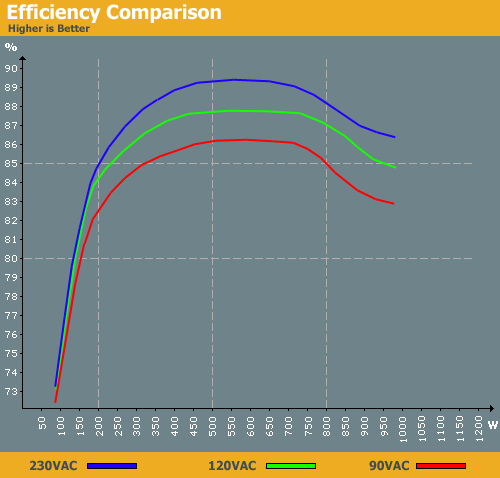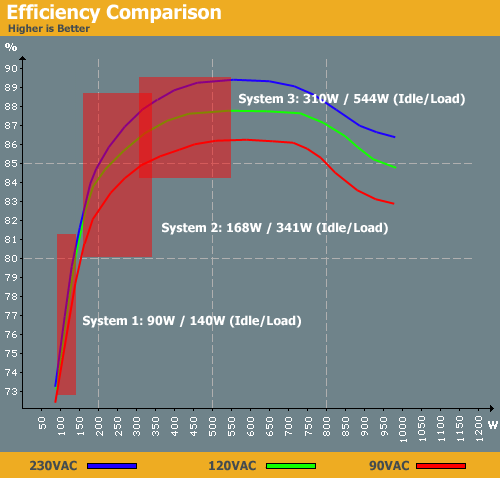Debunking Power Supply Myths
by Christoph Katzer on September 22, 2008 3:00 AM EST- Posted in
- Cases/Cooling/PSUs
Efficiency Explained
All power supplies have a specific efficiency curve, which we show in our reviews. As an example, we will use the Cooler Master UCP 900W power supply. Here is the efficiency curve we measured during testing:

Efficiency is the output power divided by the input power, as there is a certain amount of power lost during the AC to DC conversion. The x-axis shows the power supply load in Watts and the y-axis shows efficiency. Let's include our three sample systems in the chart see what sort of efficiency they would get with this power supply.

The first system causes this high-performance power supply to only run at 73% to 81% efficiency, depending on input voltage. Obviously, there's absolutely no need for a 900W power supply if you're running this type of computer.
The midrange system looks quite a bit better, allowing the PSU to run at 80% to 88% efficiency, although the latter only occurs at maximum load. Considering the vast majority of systems rarely run at 100% load most of the time, real-world efficiency will average closer to 82%. Office work and Internet surfing in particular will be at that level.
For the third system, a 900W power supply actually might start to make sense. It's still more than you need, but having a bit of extra room to grow isn't a bad idea. This system idles at over 300W, so it achieves a minimum 86% efficiency with 120VAC. When running a game or other demanding task, the PSU is finally able to reach its potential and provide 89% efficiency with 230VAC (or 87.5% with 120VAC).
The quick summary then is that if you don't have a system that uses 350W of power when idle, it's probably not worthwhile to purchase this type of power supply. Our high-end sample system more or less meets this qualification, and if you were to take such a system and overclock it, these high-end power supplies are actually required. The 8800 Ultra is one of the most demanding graphics cards currently available; however, the GTX 280 appears to require even more power, making that another candidate for this sort of PSU. (Unfortunately, our power supply testing labs didn't have the latest GPUs available for testing.)










98 Comments
View All Comments
BernardP - Monday, September 22, 2008 - link
The following paragraph from the article has me puzzled:"It's important to have one 12V rail supply the CPU with power and the second rail for the PCI-E slots and 6-pin connector. Unfortunately, many companies make a tremendous mistake when it comes to power distribution. We have seen several power supplies that use one 12V rail for the 6-pin PEG connector and then a second 12V rail for the CPU and 24-pin ATX connector. That means if you have a graphics card that doesn't include a 6-pin jack, both the CPU and GPU will use the same 12V rail for power. In this case, the second 12V rail goes completely unused, and users risk drawing too much current on the remaining 12V rail."
I have an Antec Eartwatts 380. How can I find out if Antec has made the tremendous mistake or not? I want to make sure that the 6-pin connector and PCI-E slot are on their own 12V rail. Antec litterature on this PS says:
"Dual 12V outputs: 12V2 for motherboard and peripherals, 12V1 for processor"
It would seem OK, assuming "peripherals" includes the 6-pin connector.
7Enigma - Monday, September 22, 2008 - link
What is your graphics card? From the article it seems to me they are saying if you do NOT have a card that requires a 6-pin PEG connector then you could possibly have an issue. If you have a card requiring a PEG connector you don't have to worry.BernardP - Monday, September 22, 2008 - link
Exactly. I am planning to add a 9500GT to my existing system (integrated graphics). No power connector on that card.Dribble - Monday, September 22, 2008 - link
http://extreme.outervision.com/powercalc.jsp">http://extreme.outervision.com/powercalc.jspSeems to return sensible values, and not only does it cover pretty well every component you might come across, but it also understands overclocking, over volting, and allows you to enter a value for capacitor ageing.
Also, here is a thread which someone has helpfully listed real power requirements (as given in reviews) for pretty well all graphic cards on the market right now:
http://archive.atomicmpc.com.au/forums.asp?s=2&...">http://archive.atomicmpc.com.au/forums.asp?s=2&...
drank12quartsstrohsbeer - Monday, September 22, 2008 - link
Hey Guys: Remember that decibels is a logrithmic scale of measurement! Using a linear scale on the graph leads to inappropriate conclusions being drawn from the data.7Enigma - Monday, September 22, 2008 - link
I don't think it does. Maybe a quick *note* at the beginning of the acoustics section mentioning its logrithmic, but it is very easy to read a linear scale.Also, the majority of the tested systems fall well below the floor of most systems (20 decibels), so it is a moot point anyway.
gmkmay - Monday, September 22, 2008 - link
I'll start off by saying good article, however I would have liked to see a few additions.Other than the aforementioned new cards and overclocking information I think it would have been helpful to include common watercooling pumps and case/system fans. There is most likely a large enough set reading this that would have liked to see those added.
The problem with the power supply issue is you have to be really careful not to get something too weak...and its really easy to forget a few small items that can quickly add up (for instance 2 pumps, 8 120mm fans, etc).
mindless1 - Thursday, September 25, 2008 - link
Nobody building a PC needs 8 x 120mm fans. Let's suppose you throttle down the fans enough that you might actually have good use for so many to have them all at very low RPM. That would tend to cause under 150mA per fan or barely over 1A total, a relatively trivial amount of power considering that even spinning up any one hard drive causes a larger momentary spike.A couple pumps shouldn't use all that much power either, but if you're pouring enough money into the system to have it that elaborate then why would you be on the fence about choosing a marginally capable PSU versus one with plenty of reserve power to the point where 3A one way or the other isn't a factor?
Anubis - Monday, September 22, 2008 - link
would be interesting to see numbers on just how much power OCing pulls over a non OCed systemChristoph Katzer - Monday, September 22, 2008 - link
I had a QX9770 just slightly overclocked with basic bios functions (for an oc-noob like me) and already then it had an increased power draw of 20% at full load compared to normal.